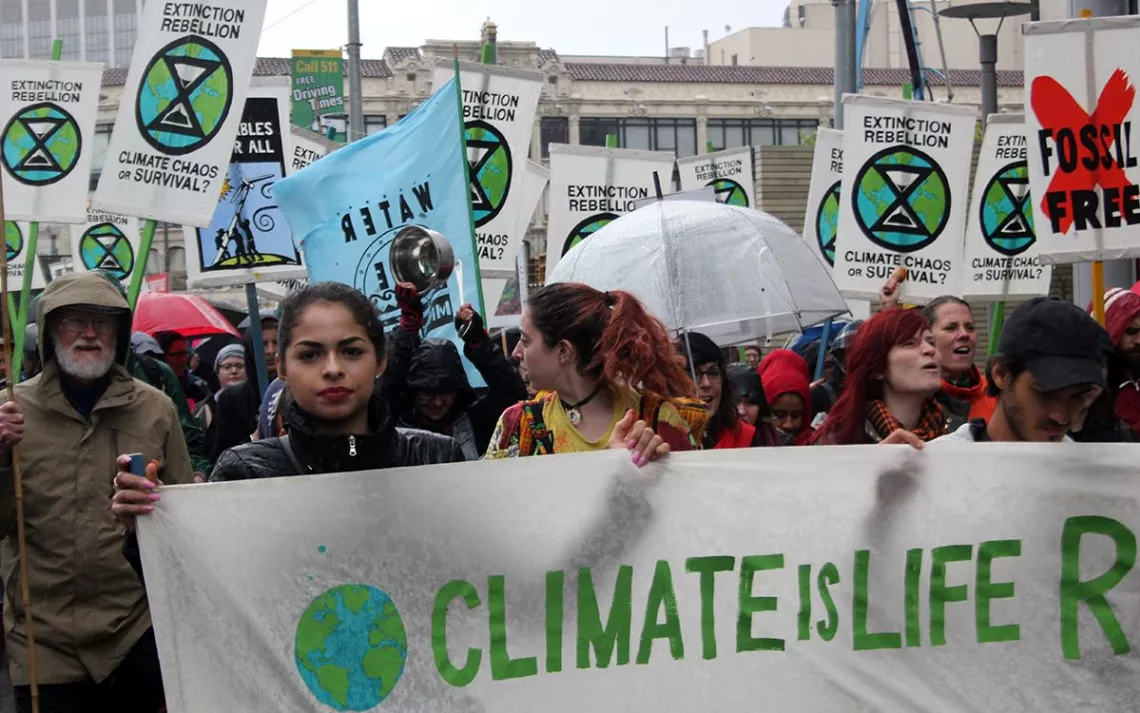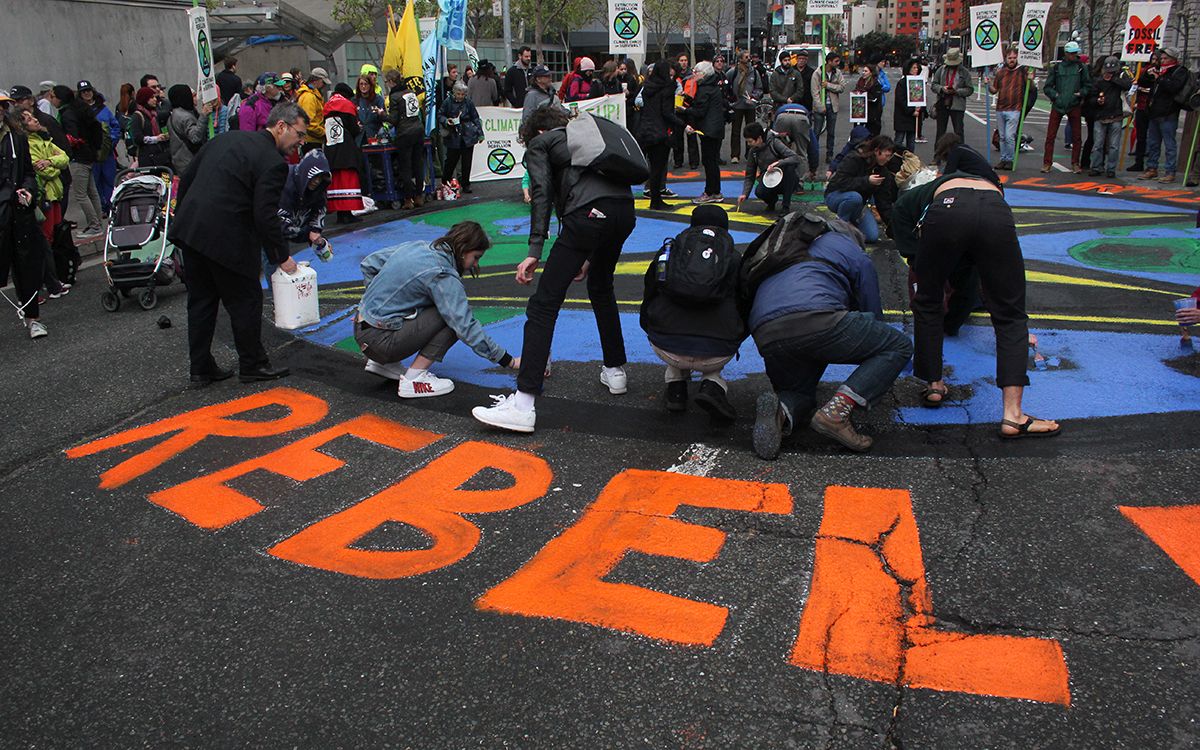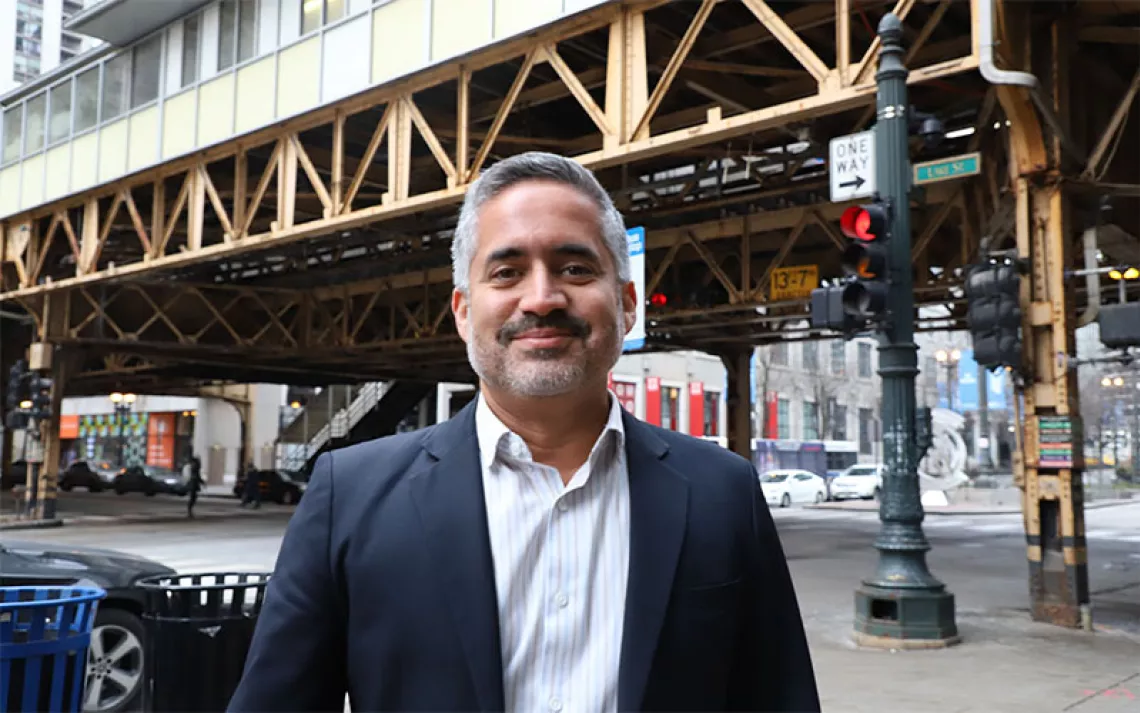Climate Activists Are Rebelling. Are Politicians Finally Listening?
Extinction Rebellion's bold antics seem to be getting results

An Extinction Rebellion protest in San Francisco in April | Photo by Lewis Page
On a rainy Monday afternoon in mid-April, several hundred protestors congregated in the street near the Federal Building in San Francisco. Most fanned out in a ring, while a few crouched on the pavement and traced a giant circle in chalk on the asphalt, then filled it in with paint. The artists looked like they were enjoying themselves, but the symbol they painted was grim: Planet Earth overlaid with a large X made to look like an hourglass. Above it, in orange, read the words “Sound the Alarm”; below it, “Rebel for Life.”
The crowd was there to protest under the auspices of the Extinction Rebellion (XR), an international movement demanding a government response to climate change, species loss, and imminent ecological collapse. Hours earlier across the Atlantic, protestors rallying around the same sign had begun to shut down London, halting traffic in five of the city’s most iconic locations. By the close of the 10-day demonstration on April 25, over 1,100 had been arrested in the UK capital.
Extinction Rebellion was initially conceived by Roger Hallam and Gail Bradbrook of Rising Up!, a UK political organization with roots in the Occupy movement. Both considered civil disobedience to be the necessary response to the International Panel on Climate Change report released in October, which warned that “rapid and far-reaching” transformation must take place within the next 12 years in order to avoid the catastrophic consequences of runaway climate change. Extinction Rebellion’s official platform includes three demands: that the government “tell the truth” by declaring a climate emergency, reduce greenhouse emissions to net zero by 2025, and create a “citizens’ assembly” to advise the transition.
The movement first received widespread attention on October 26, when nearly 100 academics published a letter of support in The Guardian. On October 31, over 1,500 protestors showed up at its inaugural demonstration in London. In the following weeks, more than 6,000 protestors took to the streets, blocking five bridges across the Thames.
The first XR demonstration in the United States was held in New York City in January. It culminated with activists scaling the golden statue of Prometheus in Rockefeller Plaza, and 19 people were arrested. Hoping to build on the growing momentum, XR organizers declared an International Week of Rebellion starting on April 15. Demonstrations were held around the world, including in South Africa, New Zealand, Colombia, Australia, and Japan.
XR operates more as a loose network than a centralized organization. Anyone who accords with its basic tenants can claim the name, use the symbol, and organize their own chapter. “It doesn’t even have to be geographically based,” said Heather Love, an organizer with XR SF Bay. A chapter for people with disabilities meets online. Though geographically and politically diverse, the movement’s adherents are drawn together by a shared sense of urgency, disillusionment with incremental change, and a flare for the theatrical.

Protestors paint the street in San Francisco | Photo by Lewis Page
During the London protests, masks, garish costumes, and cartoonish signage were the norm. One group of protestors placed a full-size bright-pink boat with the words “Tell the Truth” emblazoned on its side at the center of their encampment in Piccadilly Circus; others brought potted plants to Waterloo Bridge, creating an insurgent garden; still others staged a “die-in” at the Natural History Museum, blanketing the floor with their bodies below a giant suspended blue whale skeleton.
At the end of the recent 10-day protest in London, organizers announced a pause from civil disobedience in order to engage with policymakers. On the whole, though, the movement emphasizes disruption over negotiation. “They’re more radical, less policy-oriented,” Andrea Shaw, a participant at the San Francisco protest, told Sierra.
But can this approach really force governments to take climate change more seriously? XR publicity materials often cite political scientist Erica Chenoweth, who argues that 3.5 percent of a population engaging in civil disobedience is enough to enact widespread change.
Whether or not Extinction Rebellion accomplishes its aims, there is no doubt that the movement’s antics are starting to reap results, especially in the UK. In an article in the Daily Telegraph, former Tory leader William Hague wrote, “It is time to recognise that these young activists are indeed focused on the right issues,” imploring fellow conservatives to take note.
And though London mayor Sadiq Khan initially disapproved of the London protests (“This is counterproductive to the cause and our city,” he scolded in a public Facebook post), he met with members of Extinction Rebellion on April 30 and agreed to consider the creation of a citizens’ assembly on climate. The next day, activists met with UK environment secretary Michael Gove, who acknowledged their concerns and pledged to reduce carbon emissions to net zero, although without a specific timeline. (“It was less shit than I thought it would be, but only mildly,” Clare Farrell of Extinction Rebellion told The Guardian.)
Then, on Wednesday, May 1, the UK parliament unanimously declared a climate emergency, becoming the first in the world to do so. While only a symbolic move, it nonetheless signals a belated but growing recognition of what is at stake.
As Clive Lewis, a Labour MP from Norwich, put it, “If you are drowning, you don’t say, 'Oooh, what’s politically possible?' You do what you have to do to survive.”
 The Magazine of The Sierra Club
The Magazine of The Sierra Club







